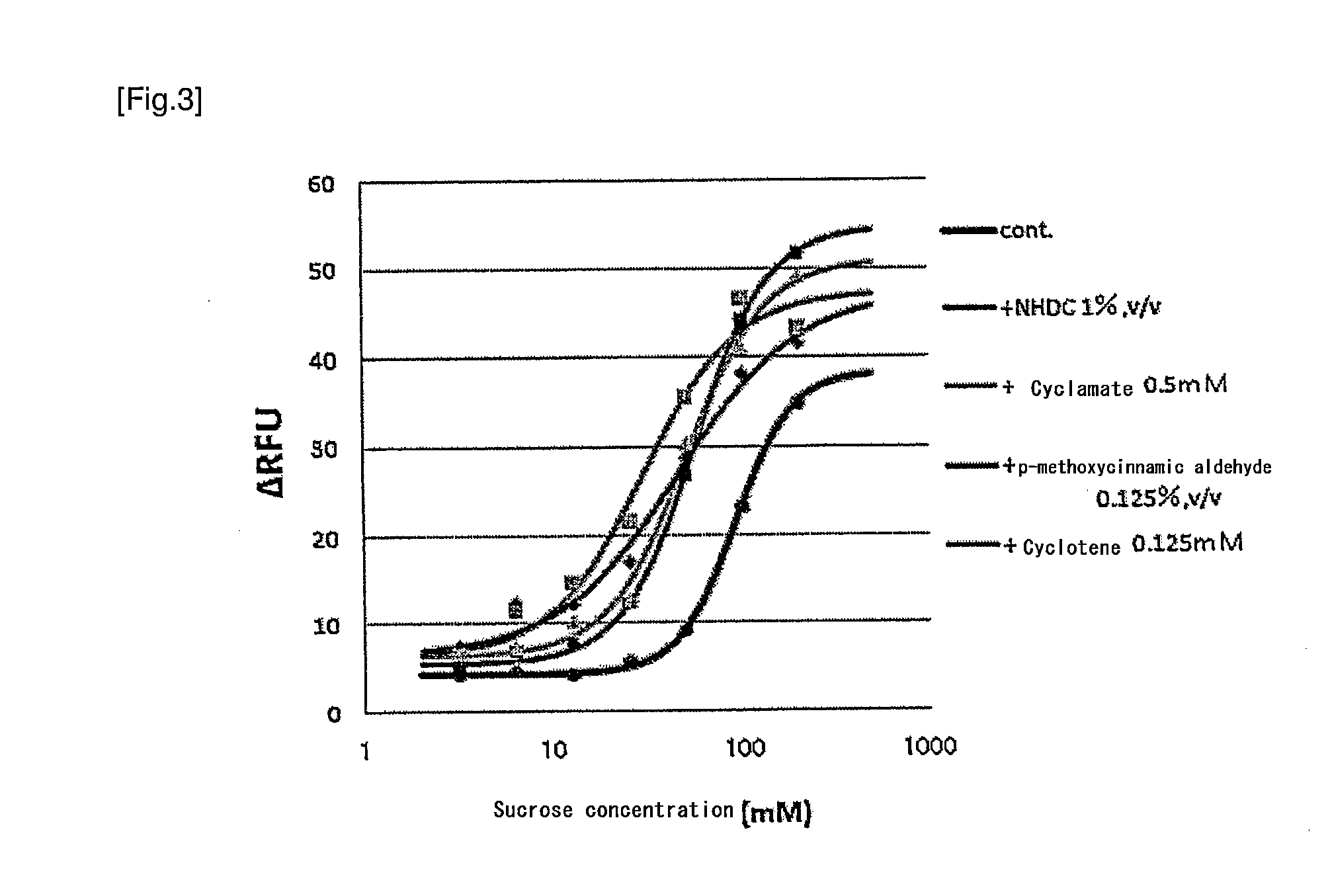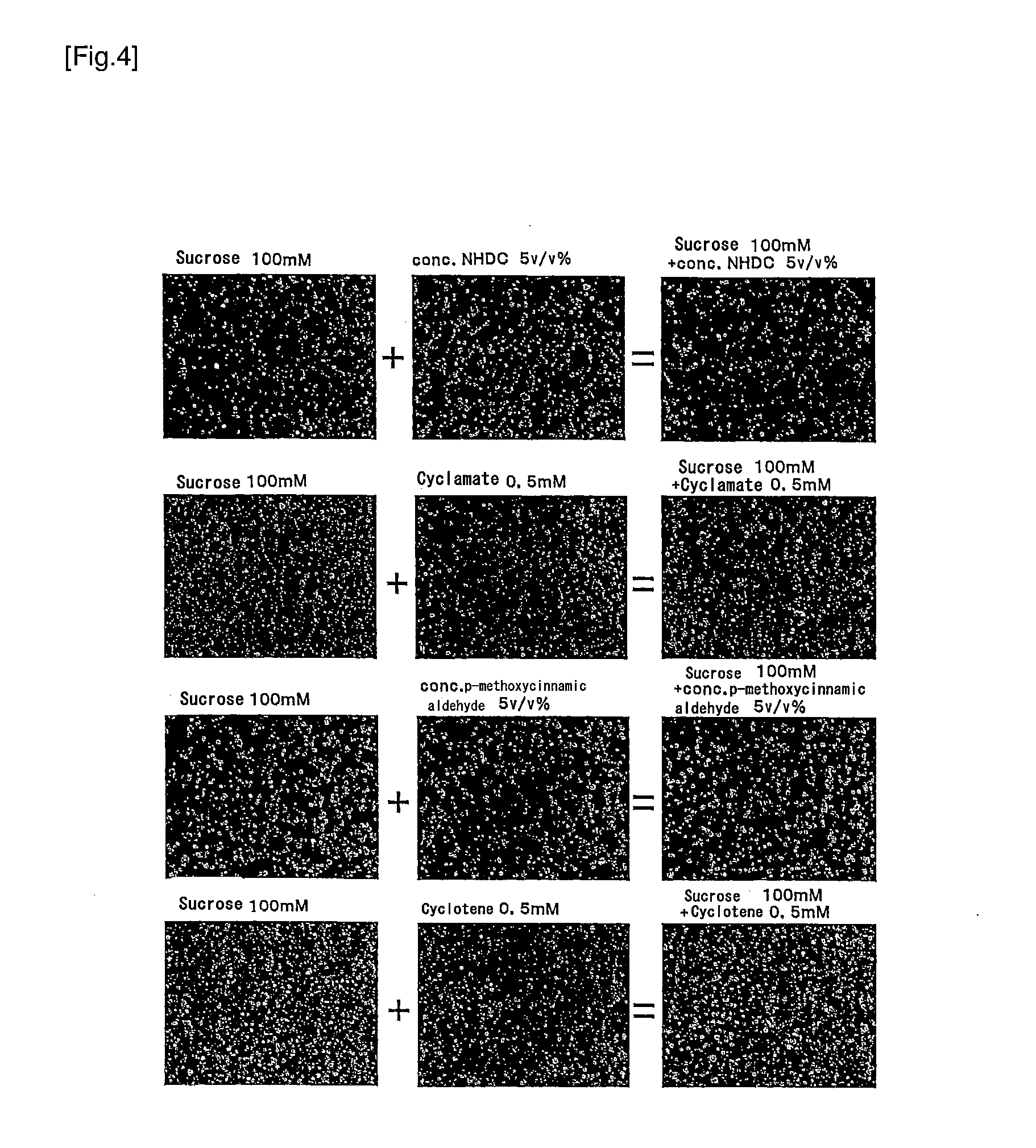Human sweet taste receptor-acting sweet taste regulating substance to sweet taste substance
- Summary
- Abstract
- Description
- Claims
- Application Information
AI Technical Summary
Benefits of technology
Problems solved by technology
Method used
Image
Examples
example 1
Preparation of Cultured Cell Strain which is Allowed to Functionally Stably Express Both of a Human Sweet Taste Receptor (hT1R2+hT1R3) and a Chimeric G Protein (hG16gust44)
[0097]First, as an expression construct, pcDNA5 / FRT (Invitrogen) (FIG. 2) having a sequence in which cDNA encoding hT1R2 and a cDNA encoding hG16gust44 are connected so that an IRES sequence is flanked by the cDNAs, downstream of an EF-1α promoter, and having a sequence in which a cDNA encoding hT1R3 and a cDNA encoding hG16gust44 are connected so that an IRES sequence is flanked by the cDNAs, downstream of a CMV promoter present downstream of this sequence, was prepared according to the following procedure.
[0098]A sense primer (SEQ ID NO:1: TATAGATCTGATATCCCCCTATGGTGCACTCTC) having a recognition sequence (5′-AGATCT-3′) of Bgl II at a 5′ end, and a recognition sequence of EcoRV immediately under therefrom, and an antisense primer (SEQ ID NO:2: TAGAAGGCACAGTCGAGG) having a sequence in a BGH pA sequence were designe...
example 2
Physiological Response of Sweet Taste Receptor-Expressing Cell to Sucrose Stimulation, when Neohesperidin Dihydrochalcone (NHDC) is Added
[0119]How a physiological response of a sweet taste receptor-expressing cell by sucrose changes by adding neohesperidin dihydrochalcone was analyzed by automated fluorescent imaging.
[0120]The sweet taste receptor-expressing cell obtained in Example 1 was trypsinized, and suspended in the DMEM medium, a cell density was measured, and each about 80 thousands of cells were seeded on each well of a 96-well plate (Corning, Cell BIND Surface).
[0121]After cultured at 37° C. for 24 hours, the medium was removed, and replaced with 50 μl of a HEPES buffer, and 50 μg of a HEPES buffer containing a fluorescent calcium indicator (Fluo-4 AM attached to Molecular Devices, FLIPR Ca 4 Assay Kit) was further added. Then, this was incubated at 27° C. for 45 minutes to prepare a cell to be subjected to automated fluorescent imaging.
[0122]Then, to the cells was added a...
example 3
Physiological Response of Sweet Taste Receptor-Expressing Cell to Sucrose Stimulation, when Cyclamate is Added
[0126]How a physiological response of a sweet taste receptor-expressing cell by sucrose changes by adding cyclamate was analyzed by automated fluorescent imaging.
[0127]In the same manner as in Example 2, a HEPES buffer containing sucrose was added to a cell to be subjected to automated fluorescent imaging, so that a final concentration of sucrose became a concentration described in Table 3, a HEPES buffer containing cyclamate was further added so that a final concentration of cyclamate became 1 mM, stimulation was performed at 27° C., a fluorescent reaction (excitation at 485 nm, fluorescence at 525 nm) from immediately after addition of the solution to after 100 seconds was measured using FlexStation 3 (Molecular Devices), and a response of a sweet taste receptor-expressing cell when cyclamate was added to sucrose was quantitated. Results are shown in Table 3 and FIG. 3.
[01...
PUM
| Property | Measurement | Unit |
|---|---|---|
| Molar density | aaaaa | aaaaa |
| Molar density | aaaaa | aaaaa |
| Molar density | aaaaa | aaaaa |
Abstract
Description
Claims
Application Information
 Login to View More
Login to View More - R&D
- Intellectual Property
- Life Sciences
- Materials
- Tech Scout
- Unparalleled Data Quality
- Higher Quality Content
- 60% Fewer Hallucinations
Browse by: Latest US Patents, China's latest patents, Technical Efficacy Thesaurus, Application Domain, Technology Topic, Popular Technical Reports.
© 2025 PatSnap. All rights reserved.Legal|Privacy policy|Modern Slavery Act Transparency Statement|Sitemap|About US| Contact US: help@patsnap.com



